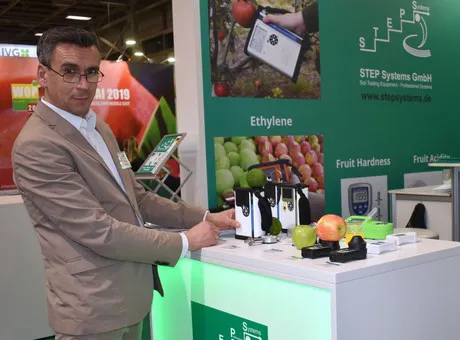Smartphones are increasingly being used as a management aid in agriculture. This also goes for the plant fertilization process. The Institute of Horticulture at the University of Applied Sciences Weihenstephan-Triesdorf (Freising, Bavaria) now wants to develop a smartphone App for field vegetable cultivation, which can determine the nitrogen content currently present in the soil by means of rapid photometric tests.
With a new software application (App), the "N-Phone" can directly calculate the amount of nitrogen to be added. "This technology could reduce the often excessive nitrogen fertilization in field vegetable cultivation," says Alexander Bonde, Secretary General of the German Environmental Foundation (DBU). And that is not only practical for the farmer, but it is good for the environment as well: Less superfluous nitrogen can get into the groundwater via the soil. The polluting effects on soil, groundwater and climate decreased. The DBU supports the project with some 320,000 euros.
Field cultivation: Animal husbandry and focus on nitrogen
"In addition to animal husbandry, intensive field vegetable cultivation is a focal point for the nitrogen input into the groundwater," says Dr. Holger Wurl, DBU specialist for environmentally friendly land use. Many vegetable crops, such as spinach, lettuce or most cabbages, have high nitrogen requirements, with sometimes short cropping and harvesting during their main growing phase. In order to achieve high yields and good quality, a lot of nitrogen must be available in a very short time and a sufficient nitrogen supply must be guaranteed until harvest time.
Wurl: "In practice, people prefer to play it safe." Therefore, more fertilizers are added than are ultimately necessary, so that the nitrogen remnants remain in the soil after the harvest, only to be washed out with the next rainfall.
Photometric method using smartphone adapter
"If nitrogen fertilization in vegetable cultivation is to be reduced without quality and yield losses, the nitrogen currently present in the soil must be precisely measured and taken into account before fertilization," explains project leader Prof. Dr. Elke Meinken from the Institute of Horticulture. While the laboratory nitrogen analysis meant a considerable financial and logistical effort, previous on-site procedures were not sufficiently accurate or placed too high demands on the gardener.
A spectrophotometric rapid process is being developed with which the amount of nitrogen in the soil can be determined on site. Photometry is a method by which the concentration of solutes can be determined by measuring their ability to absorb light.
N-Phone measures, calculates and interprets analysis
In addition to this, the Horticultural Institute plans to program an App that will evaluate the info, determine the level of nitrogen in the sample, and provide results with data related to each vegetable and some other information of the user. Subsequently, the farmer receives a precisely tailored fertilizer recommendation directly on site. "In this way, the smartphone acts as a central operating, measuring and interpretation tool," says Meinken.

STEP Systems GmbH is one of the cooperation partners. In the picture: Contact Marjan Karlovic at the booth at this year's Fruit Logistica. Image: Freshplaza
High acceptance for practical application
Smartphones are already widely used in agriculture, and the project participants will partner with STEP Systems GmbH (Nuremberg). If fertilizing field crops causes too much plant-available nitrogen to reach the groundwater via the soil, there may be nitrate levels above the EU 50-milligram limit. In Germany, 61 percent of drinking water is derived from groundwater. Since excessively high nitrate levels in drinking water can be detrimental to health, contaminated groundwater must be treated to make it drinkable. This is expensive and associated with high costs. The aim is therefore to keep nitrate pollution of groundwater low from the outset, so it no longer needs to be processed.
Excessive nitrogen fertilization can also pollute the air and increase the amount of greenhouse gases in the atmosphere, thereby contributing to climate change. "If the development of the N-Phones is successful and is then used extensively in vegetable cultivation, it optimizes nitrogen fertilization and leads to better groundwater quality," says Bonde.
For more information: www.dbu.de
